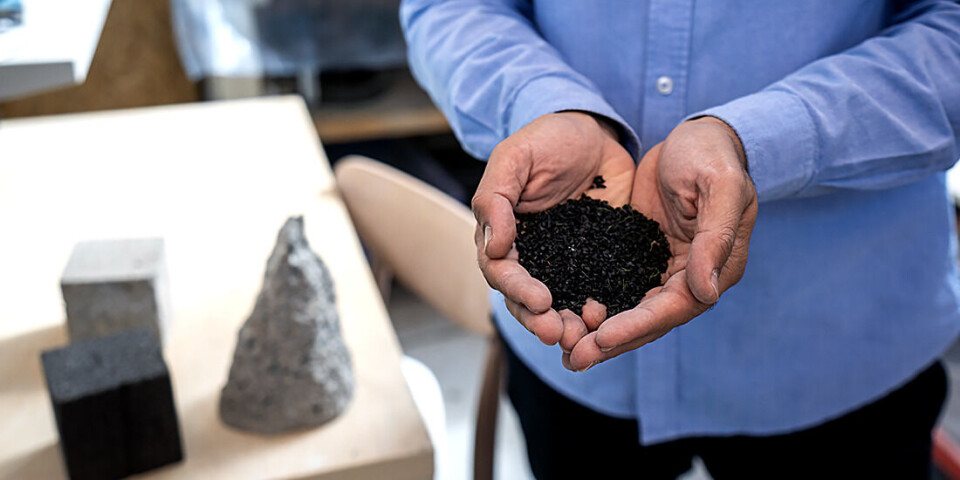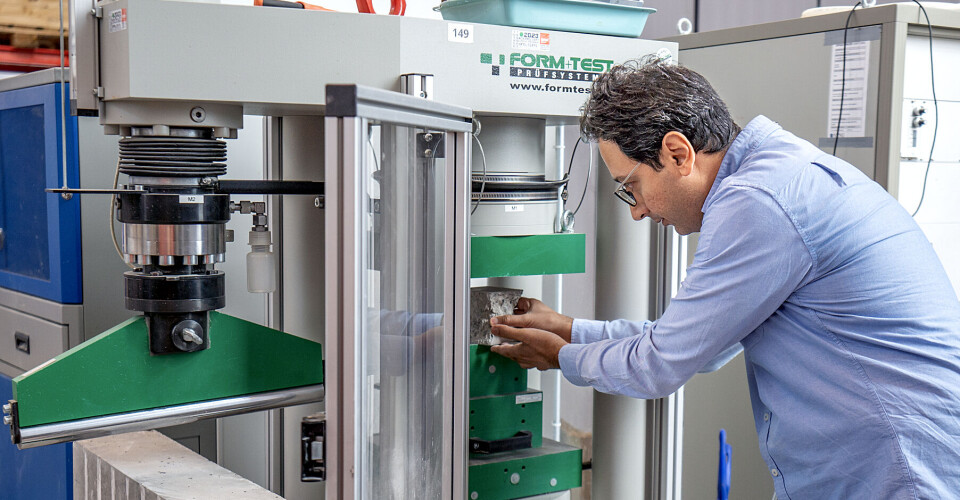THIS CONTENT IS BROUGHT TO YOU BY NTNU Norwegian University of Science and Technology - read more

Can microplastics be used to make concrete?
Rubber granules from artificial grass pitches will be phased out, but what do we do with the thousands of tonnes of microplastics that are left?
You have probably seen them, the black granules that bounce up in the air when the ball hits the artificial grass. However, keeping them in one place is not an easy feat. The unruly rubber granules stick to clothes, are washed away by the rain, and shovelled up with the snow.
They have made artificial grass pitches one of the largest sources of microplastic pollution in Norway.
In a report from the Norwegian Environment Agency, it is estimated that close to 6,000 tonnes of microplastics are lost from artificial turf in Norway annually. That is almost one-third of the total microplastic pollution.

Phasing out these granules had already been in the cards for a while when the European Commission voted to ban the sale of rubber granules in April 2023. All artificial grass pitches covered with rubber granules must be replaced within a transitional phase of eight years after the ban comes into effect.
But how can thousands of tonnes of difficult-to-recycle waste be dealt with in an environmentally sound way?
Concrete is the second most used substance in the world
Mohammad H. Baghban is an associate professor at NTNU. His research interests include concrete technology, and he may have identified a possible solution.
“The construction industry accounts for approximately 40 per cent of the world’s greenhouse gas emissions, generates large volumes of waste, and is often involved in serious encroachments on nature. How we build our houses, schools, and roads therefore has a big impact on the climate and the environment overall,” he says.
The type of building materials we use and how we produce them are absolutely crucial in this respect. Today, concrete is by far the most used building material.
“After water, concrete is actually the most widely used substance in the world,” says Baghban.
Can replace sand and stone in concrete
Baghban’s research could potentially have very large ripple effects. Just a small improvement in concrete technology can have a significant impact on the global climate and environment.
Baghban and his colleagues have now investigated what happens to concrete when rubber granules are added to it, and the results point to a win–win situation.
“One thing is that this is a way of reusing a type of waste that is difficult to recycle. Another is that it provides concrete manufacturers with an easily accessible and inexpensive aggregate,” Baghban says.
Aggregate is the main component of concrete and can make up as much as two-thirds of the finished product. Common aggregates are sand and stone, and the extraction of these often involves significant encroachments on nature, the researcher explains.

“A lot of the aggregate used today consists of natural sand. Natural sand is not a renewable resource, and many places around the world are now actually starting to run out. This has led to people looking for alternative solutions, such as blowing up rock and then crushing it to the appropriate size,” Baghban says.
The fact that rubber granules can replace some of the need for natural aggregates is therefore good news for the environment.
There is no imminent risk of running out of rubber granules either; rubber granules are mainly made from discarded car tyres, which are certainly not in short supply.
But how does concrete with added rubber granules actually perform in practice compared with traditional concrete?
Concrete should not only be strong
“We often hear about the strength of concrete, but other characteristics are also important,” says Baghban.
He explains that concrete is also assessed on the basis of criteria such as exposure and durability classes.
“When producing paving stones, curb stones, and light clinker slabs, it's very important that the concrete is durable and can withstand stresses from the surrounding environment. In such cases, concrete with added rubber granules can have beneficial results,” the researcher says.
In addition, adding rubber granules in appropriate amounts does not necessarily have a significant impact on the strength of the concrete.
“By-products from other industries, such as slag and fly ash, for example, can also have a positive effect on the strength of this type of concrete. These are types of waste that you might otherwise have spent a lot of money getting rid of, but which, like rubber granules, can be given a new life in concrete structures,” he says.
May soon be put into use
Baghban sees opportunities to use rubber granules as aggregate in concrete in the near future.
“What remains is to get rubber granules approved as an aggregate that can be used in concrete. In certain contexts, such as construction concrete, there may be a long process before a decision can be made. However, if the concrete is to be used for the production of curb stones and paving stones and the like, it's easier to get approval,” he says.
References:
Baghban et al. 'Carbonation Depth and Chloride Ion Penetration Properties of Rubberised Concrete Incorporated Ground Blast Furnace Slag', Solid State Phenomena, vol. 329, 2022. DOI: 10.4028/p-ag9ej7 (Abstract)
Sundt et al. Norske landbaserte kilder til mikroplast (Norwegian land-based sources of microplastics), the Norwegian Environment Agency, 2021.
———
Read the Norwegian version of this article on forskning.no
More content from NTNU:
-
Politics on Facebook: Populist parties choose divisive issues on purpose
-
Social media is connected to cyberbullying – but not how we thought
-
Forskere ved NTNU får nesten 24 millioner av EU for å lage nye strømomformere
-
This helps the youngest children enjoy school more
-
Can we tap the ocean’s power to capture carbon?
-
Researchers have uncovered major problems in Norway's salmon industry





































